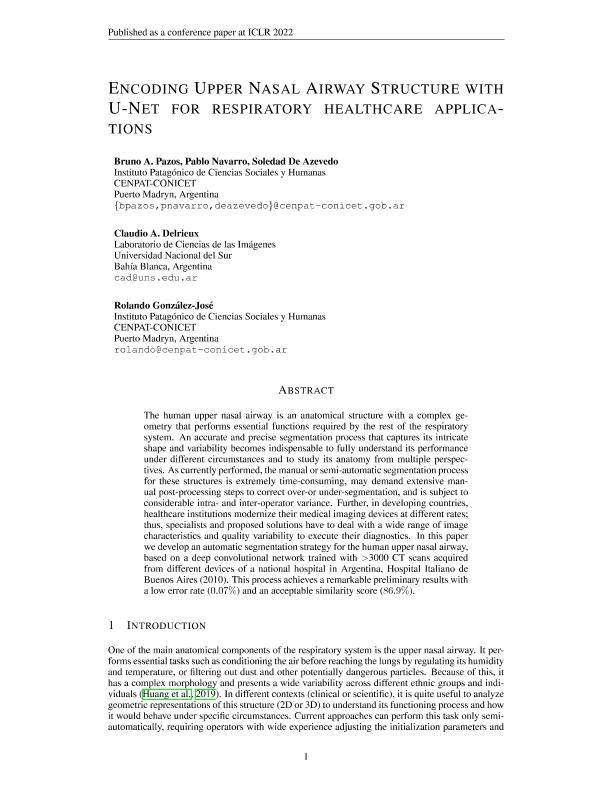Evento
Encoding upper nasal airway structure with U-Net for respiratory healthcare applications
Pazos, Bruno Alfredo ; Navarro, Jose Pablo
; Navarro, Jose Pablo ; de Azevedo, Soledad
; de Azevedo, Soledad ; Delrieux, Claudio Augusto
; Delrieux, Claudio Augusto ; Gonzalez-Jose, Rolando
; Gonzalez-Jose, Rolando
 ; Navarro, Jose Pablo
; Navarro, Jose Pablo ; de Azevedo, Soledad
; de Azevedo, Soledad ; Delrieux, Claudio Augusto
; Delrieux, Claudio Augusto ; Gonzalez-Jose, Rolando
; Gonzalez-Jose, Rolando
Tipo del evento:
Workshop
Nombre del evento:
3rd Practical Machine Learning for Developing Countries: learning under limited/low resource scenarios
Fecha del evento:
29/04/2022
Institución Organizadora:
Comité organizador del Practical Machine Learning for Developing Countries;
Título del Libro:
3rd Practical Machine Learning for Developing Countries: Learning under limited/low resource scenarios
Editorial:
Comité organizador del Practical Machine Learning for Developing Countries
Idioma:
Inglés
Clasificación temática:
Resumen
The human upper nasal airway is an anatomical structure with a complex geometry that performs essential functions required by the rest of the respiratory system. An accurate and precise segmentation process that captures its intricate shape and variability becomes indispensable to fully understand its performance under different circumstances and to study its anatomy from multiple perspectives. As currently performed, the manual or semi-automatic segmentation process for these structures is extremely time-consuming, may demand extensive manual post-processing steps to correct over-or under-segmentation, and is subject to considerable intra- and inter-operator variance. Further, in developing countries, healthcare institutions modernize their medical imaging devices at different rates;thus, specialists and proposed solutions have to deal with a wide range of image characteristics and quality variability to execute their diagnostics. In this paper we develop an automatic segmentation strategy for the human upper nasal airway, based on a deep convolutional network trained with >3000 CT scans acquired from different devices of a national hospital in Argentina, Hospital Italiano de Buenos Aires (2010). This process achieves a remarkable preliminary results with a low error rate (0.07%) and an acceptable similarity score (86.9%).
Archivos asociados
Licencia
Identificadores
Colecciones
Eventos(IPCSH)
Eventos de INSTITUTO PATAGONICO DE CIENCIAS SOCIALES Y HUMANAS
Eventos de INSTITUTO PATAGONICO DE CIENCIAS SOCIALES Y HUMANAS
Citación
Encoding upper nasal airway structure with U-Net for respiratory healthcare applications; 3rd Practical Machine Learning for Developing Countries: learning under limited/low resource scenarios; Argentina; 2022; 1-7
Compartir



